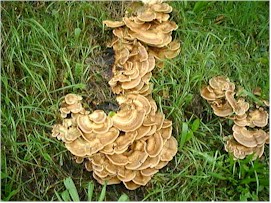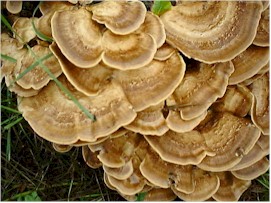 Common Name(s):
Common Name(s):| Giant Polypore |
 Common Name(s):
Common Name(s):
Scientific Name(s):
Meripilus giganteusType:
FungusPrinciple Host Trees & Shrubs
: Deciduous trees, mainly beech and oak.Description, Development & Diagnosis:
The brackets produced by this fungus appear annually in late-summer to autumn. The fungus is parasitic, feeding upon the heart wood of its host tree, it creates the fruiting bodies (brackets) as part of its reproduction process; it is the fruiting bodies that produce and release the spores into the air.
 The
brackets are numerous, fan shaped, arranged as a rosette. Each bracket can be large upto
300mm across. The upper surface is zoned light brown to dark brown, becoming darker
with age, the underside is white. The flesh is white, thin and fibrous. The brackets
eventually disintegrate into a black mass with the appearance of the first frosts.
The
brackets are numerous, fan shaped, arranged as a rosette. Each bracket can be large upto
300mm across. The upper surface is zoned light brown to dark brown, becoming darker
with age, the underside is white. The flesh is white, thin and fibrous. The brackets
eventually disintegrate into a black mass with the appearance of the first frosts.
This fungus is normally found at the base of the tree trunk, on old stumps or on roots. They can sometimes be seen growing on submerged roots some distance from the tree.
Significance:
This fungus is common and widespread in Britain. It is a parasitic decay fungus producing a soft brown decay within beech. As with all heart wood decay fungi, its appearance is significant and should be investigated.
Control:
No practical control. Removal of fungal brackets as they appear will reduce levels of spore production and limit the spread of the disease on to other trees but this would not normally be considered as an effective method of disease control and should only be considered in a high risk situation.
Please Note: Many Fungi are toxic and individual reactions to them vary widely. Do not touch or eat fungi unless you have accurately identified them. Chris Skellern can not accept any legal responsibility or liability for errors in identification or for individual reactions to the consumption of fungi.
| Further Information. |
© 2001 Chris Skellern. AIE. Home | News | A-Z Index | Resources | Contact AIE | Terms of Use